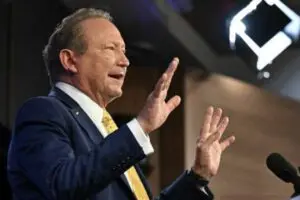Fortescue Metals, the iron ore giant controlled by billionaire Andrew Forrest, says it will spend at least $1.2 billion on its green energy division in the coming year, as it continues work on the roll-out of its hydrogen and battery technologies, and lays the groundwork for some major green hydrogen projects.
Fortescue stunned the market early on Monday with the surprise departure of CEO Fiona Hicks after just six months in the job, continuing the revolving door in the ranks of the iron ore miner.. She has been replaced by the chief operating officer Dino Otranto.
The company’s annual results announcement was anchored by the head of Fortescue Future Industries, Mark Hutchinson, who joined the company a year ago. Otranto joined in 2021.
Hutchinson said Fortescue Energy will be now comprise three divisions as it leads the company’s goal of reaching “real zero” for its Pilbara iron ore operations by 2030, meaning no use of fossil fuels, and no buying of carbon offsets beyond the current fiscal year unless it is forced to by government policy.
“It has long been our view that offsets must only be used as a temporary solution while the technology or innovation required to decarbonise completely is developed,” Hutchinson said.
Fortescue Energy will now comprise three divisions that separately address battery storage, hydrogen electrolyers, and the massive projects it intends to bring to market to meet its ambitious green hydrogen production targets.
Fortescue Future Industries will focus on green energy project development and production, and still hopes to make financial investment decisions on at least five green energy projects in Australia, the US, Norway, Brazil and Kenya by the end of the year.
Fortescue WAE, which comprises the Williams Advanced Engineering business that it bought last year, will focus on battery and fleet technology developments, particularly on its significant heavy haulage and rail transport.
Fortescue Hydrogen Systems will focus on electrolyser and hydrogen production systems development and manufacturing, including the Gladstone manufacturing facility that will role out its in-house photon exchange membrane (PEM) electrolyser stacks.
Fortescue says it will spend $1.2 billion over the coming year on Fortescue Energy – $800 million on operating costs and another $400 million on capital costs, which includes its hydrogen and battery manufacturing facilities, but not any of the massive green hydrogen projects it plans to commit to by the end of the calendar year.
The investment is being funded by the huge cash flow it generates from its iron ore operations. In the last year, the company reported underlying earnings of $US10 billion, and a bottom line net profit of $US4.8 billion, even after a $US726 million non-cash impairment charge relating to developments at its latest mine at Iron Bridge.
The company says its “real zero” commitment for 2030 means no carbon credits and no burning of fossil fuels, anywhere in its business.
Fortescue says it has a “good idea” how to reduce 90 per cent of those emissions, but it is the last 10 per cent where the technology options are not settled. This includes blasting in its mines, and remote gen-sets used across its operations.
“So, for over 90 per cent we have a really good idea what to do and we zeroing in on a very limited number of technological partners to get there,” said the company’s head of decarbonisation Christiaan Heyning.
“On the remaining 10 per cent, there’s still a wide range of opportunities to sort of technical ways of achieving that emission reduction. And that means that we are still earlier in the process in deciding which way to go.”
Fortescue’s emissions are currently 2.5 million tonnes (scope 1 and scope 2), but this increase significantly over the near term will increase because of its ramping up of its new Iron Bridge mine.
However, the new CEO Otranto says the bulk of these will be reduced by the use of wind and solar on a large scale – they currently provide only 20 per cent of its electricity use – as well as battery and hydrogen trucks (and even trailing cables) that it is now trialling at its mine sites.
The company is building a 100MW solar farm at North Star Junction, located near Iron Bridge, which will provide up to 30 per cent of its Pilbara daytime stationary energy needs. The 60MW Chichester solar farm which was commissioned in 2021 provides up to 100% of Christmas Creek’s and Cloudbreak’s daytime energy needs.
The company estimates it will need between 2GW and 3GW of wind, solar and battery storage to eliminate fossil fuels from its Australian iron ore operations. It says feasibility studies are underway for proposed wind and solar generation sites.
Of its total iron ore mining emissions, 25 per cent came from mining heavy haul diesel trucks and other 35 per cent came from other heavy mobile equipment that uses diesel.
A further 13 per cent came from stationary power (gas, diesel), 12 per cent from marine vessels under its control, 11 per cent from diesel rail, and 4 per cent from other sources.
The solutions – beyond the wind and solar, grid scale batteries, demand response and reserve power provided by a green fuel such as green ammonia for stationary power – include green ammonia or green methanol for ore carriers, and battery hybrid vessels (with green ammonia or hydrogen) for tugs.
Other solutions include its proposed battery-powered “infinity train” for rail, and a mixture of batteries, trailing cables from the power grid or green hydrogen fuel cells for its heavy haulage trucks.
Chairman Andrew Forrest, who hosted a massive party at the company’s Pilbara operations over the weekend, did not participate in the call.
But in a message in the company’s climate report, which detailed some of the temperature records and potential climate tipping points, he explained the company’s decision to drop carbon offsets.
“Offsets are a fiction: as a result, you get a nice, linear decline in your emissions that is both pleasing on the eye and incredibly deceptive. As you will see in this report, we are doing things differently,” he wrote.
“We are actually eliminating fossil fuels – and from now on, we are also eliminating voluntary carbon offsets. We will not buy offsets unless legally required to do so. The science is clear: planting trees is great for the environment, but it won’t hold off the planetary scale meltdown we are experiencing.”











